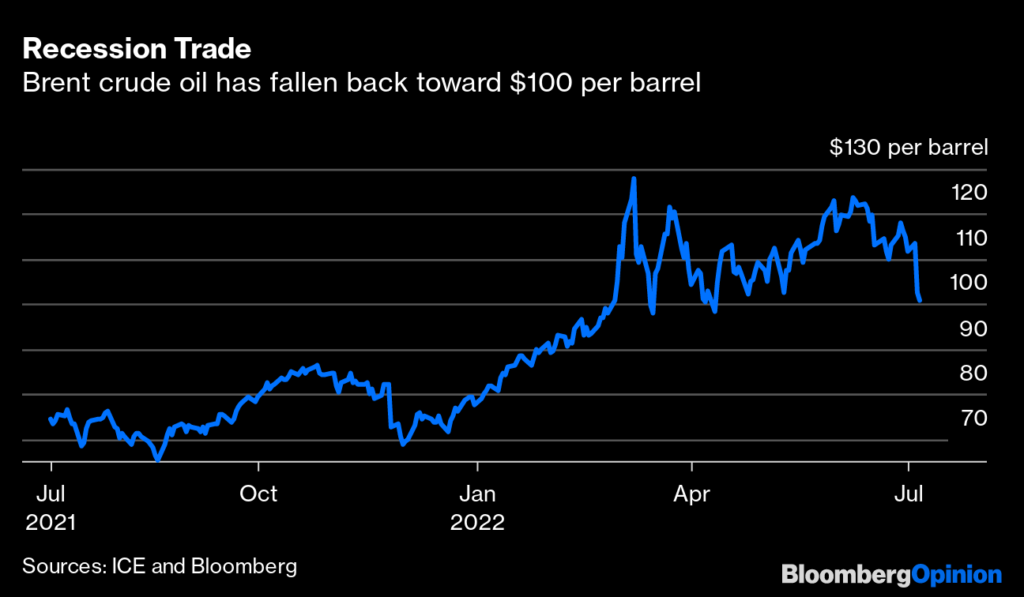
By Javier Blas
The oil market suffered a brutal selloff this week, prompting concern about a repetition of the 2008 boom-and-bust cycle. Back then, Brent jumped to a record high of almost $150 a barrel in July but ended the year below $40 as the global financial crisis deepened. This time, though, weakness in the financial oil market is at odds with the strong physical crude market.In absolute terms, Tuesday’s $10.73-a-barrel one-day plunge was the third largest since the launch of the Brent oil futures market in 1988. Even if in percentage terms the 9.45% fall only ranked as the 20th-biggest decline in a single trading session, it was still nerve wracking for oil bulls. The losses extended Wednesday with Brent falling below $100 a barrel, down 17% from the peak a month ago of almost $122.
Undoubtedly, the oil outlook for the coming months and into 2023 has deteriorated over the last month or so. Europe is probably in recession, and the health of its German economic locomotive is imperiled by surging natural gas and electricity prices. The prospect of energy rationing this winter on the continent is very real. At the same time, high retail fuel prices are starting to dent oil demand growth as preliminary gasoline sales in the US over the recent Independence Day holiday weekend suggest. The supply picture has brightened a tiny bit; Russian oil production is falling less than expected, and Washington has signaled it’s not interested in pushing it lower.
That alone would justify a price correction; but the economic slowdown would have to prove far steeper to push Brent below $80 to $90 a barrel sustainably, let alone to the $65 price suggested by some banks. There’s still a strong gravitational pull at the round number of $100.

Oil was one of the biggest winners during the first half of the year for many investors, and some have cashed in as the second half started, using commodity profits to cover losses in the equity and bond markets.
For now, at least, the physical market remains strong. OPEC+ has boosted production to near its limit, with only Saudi Arabia and the United Arab Emirates able to increase output any further. At the same time, Chinese oil demand is quickly recovering from the April-May lockdowns. The roads of Shanghai are again jammed. If the physical oil market isn’t tighter, that’s because Washington is selling huge amounts of crude from its Strategic Petroleum Reserves, capping prices. At about one million barrels a day, the sales are larger than the production of some OPEC nations. But those releases will either end by October, or their size will be reduced.
Russia can weaponize its oil exports — or those of neighboring Kazakhstan — any day, reducing supplies to a hungry global energy market. Oil investors seem oblivious to the machinations in Moscow, very much as the gas market was in April, May and early June. Back then, European natural gas futures even plunged below 100 euros ($101) per mega-watt hour, and some talked about oversupply. Since then, Russia has sharply reduced gas exports to Germany, Austria, Italy and several other nations in Europe. On Tuesday, European gas prices surged to 175 euros. Assuming that Russia won’t use its oil exports for economic warfare is to ignore everything that has happened so far this year in the energy market.

While oil derivatives markets sold off on Tuesday, physical crude markets held up rather well. North Sea, Mediterranean and West African crude varieties are selling at record, or near record, premia against the Brent oil benchmark. In another example of strength, Saudi Aramco set the official selling price for its flagship Arab Light to northwest Europe at a record high premium to Brent. For Asia, its largest market, it was set at the second-highest ever level.
Despite the selloff, oil time-spreads remain very strong. Nearby oil contracts continue to trade at a big premium to contracts for later delivery. The downward curve slope, known as backwardation, is a hallmark of a very tight physical oil market. At about $4 a barrel, the front-to-second front month backwardation is near its strongest ever. Back in July 2008, the oil time-spreads were in the opposite condition: a contango, with spot barrels at a discount to forward contracts, a sign of an oversupplied market.
So why did oil prices fall so much on Tuesday? Liquidity in oil market futures is very poor, leaving them vulnerable to anyone unwinding a large position or selling forward contracts. Both happened this week. Over the summer, several big producer-hedging deals are likely, including the annual deal used by the Mexican government to lock in prices for the following year. On Tuesday, oil traders reported Wall Street banks buying put options for 2023 in large size — likely a sign that a big client was in the market hedging oil prices. Don’t misinterpret one day’s price decline as presaging a relaxation of the pressure that’s pushed Brent up by more than 50% in the past year.
________________________________________________________________
Javier Blas is a Bloomberg Opinion columnist covering energy and commodities. He previously was commodities editor at the Financial Times and is the coauthor of “The World for Sale: Money, Power, and the Traders Who Barter the Earth’s Resources.” @JavierBlas. Energiesnet.com does not necessarily share these views.
Editor’s Note: This article was originally published by Bloomberg Opinion, on July 07, 2022. All comments posted and published on EnergiesNet.com, do not reflect either for or against the opinion expressed in the comment as an endorsement of EnergiesNet.com or Petroleumworld.
Use Notice: This site contains copyrighted material the use of which has not always been specifically authorized by the copyright owner. We are making such material available in our efforts to advance understanding of issues of environmental and humanitarian significance. We believe this constitutes a ‘fair use’ of any such copyrighted material as provided for in section 107 of the US Copyright Law. In accordance with Title 17 U.S.C. Section 107. For more information go to: http://www.law.cornell.edu/uscode/17/107.shtml.
energiesnet.com 07 08 2022












